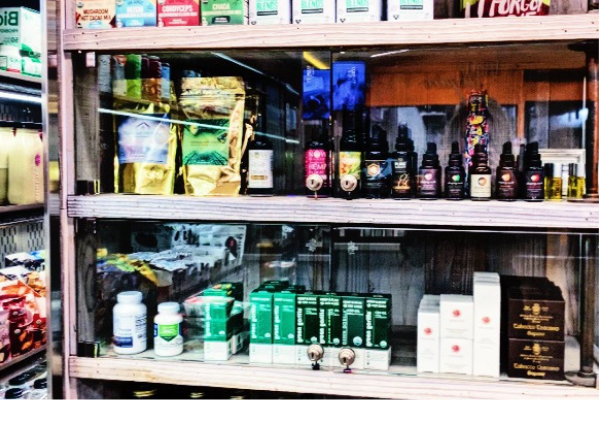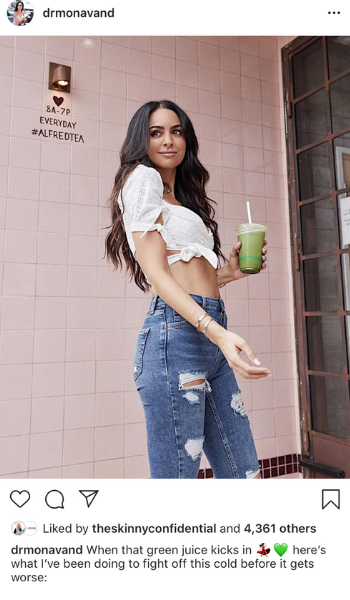
Popular wellness guru and influencer Dr. Mona Vand starts her day at 6 a.m. by turning on her essential oil diffuser.
The aroma of lavender and peppermint calm her as she makes her daily “detox drink” with lemon juice and apple cider vinegar, which she tells followers promotes weight loss and gut health. The pharmacist then slips into a lilac workout outfit before starting her yoga practice. After yoga, she has a smoothie full of leafy greens and superfoods.
Roughly 217,000 people, including college students, currently follow Vand on Instagram. Millions follow wellness influencers like her on various platforms.
A Pepp Post poll of 61 students found that just over 34 percent of students said social media influencers inspire them to implement wellness trends into their life.
Along with many other students, junior psychology major Chiara Witucki said she is skeptical of the wellness trends.
“People see the trends as some sort of ‘cure all’ or magic,” Witucki said. “I do not think it is necessary for students to do those things.”
After speaking with several students and experts, the majority said that they believe the trends made popular by the wellness craze are unrealistic for college students.

Influencers impact on their followers
Public Relations Professor Klive Oh said there is a perceived relationship that a follower has with an influencer. The influencers become like friends or family that the followers trust based on the influencer’s inherent qualities, such as their number of followers or their engagement.
“You aspire to be like them (the influencers),” Oh said. “These are beautiful people. These are funny people. So when they promote a product, the idea permeates through more easily because they have more credibility.”
Oh, however, advises students to be wary of what influencers promote because there are no regulations around what they can post. He said he worries that what some influencers endorse may be unsafe and can negatively affect people either physically or emotionally.
“There are not enough regulations, and not just government regulations but self regulations and morals,” Oh said.
People are not turning to health experts or doctors for wellness advice but A-listers.
“We’ve allowed celebrities and social media influencers to become the be-all end-all of not only status, stature, and wealth, but also the experts on literally everything and anything … including science and health,” Beth McGroarty, director of research and public relations at the Global Wellness Institute, told Marie Claire in a January 2019 article.
Lauren LeBouef, a San Diego-based wellness influencer with over 35,000 followers on Instagram, said she is fearful of how some things other influencers promote may affect their followers.
“It’s kind of scary,” LeBouef said. “These younger girls are getting all their advice from other girls who may not really know what they are talking about in the health and fitness realm.”
Wellness trends on social media
First-year business administration major Roxy Luckey said influencers definitely sway her consumer habits when it comes to choosing beauty and wellness products.
“When I need ideas for stuff, it’s my first instinct to go on Instagram,” Luckey said. “If I want to buy a beauty product it’s like ‘Oh what’s most popular? What are other people using?’”
While she doesn’t follow specific wellness trends, she said she knows people who do.
Junior psychology major Amanda Frick said she is more influenced by her friends than seeing influencer marketing on social media platforms.
“If I see my friends post on social media that they are drinking celery juice or whatever trend it is, it makes me think, “Oh that’s a good idea,” Frick said.
By seeing her peers implement these trends, she said it makes it seem more attainable for her to also be able to implement the trends into her own life.
New York-based fitness influencer Danielle Debernardo said it is important to be authentic and vulnerable with followers in order to effectively reach them.
“People don’t relate to someone who is perfect all the time, has six pack abs, and eats salads for breakfast, lunch and dinner,” Debernardo said. “People relate to someone who goes out on the weekends and may get a little hungover but still makes the effort to go to the gym.”
Taleah Phillips, sophomore economics major and SunLife Organics worker, said social media effects SunLife’s store inventory.
“I’ve heard my boss talk about our Instagram account and what we should and shouldn’t post,” Phillips said. “It’s super interesting. It definitely has a role in what we sell in the store. Like the CBD oil or the celery juice, we put it in the store because it is so popular on social media.”
Popular wellness trends among students
The poll found that the most popular wellness habits among students are the use of essential oils, the use of CBD products and drinking apple cider vinegar in the morning. Around a third of students said that they did not participate in any trends at all.
Phillips said her favorite wellness trend is drinking celery juice.
“It’s like really hydrating and it just feels good to drink it. I feel a difference,” Phillips said. “I also put supplements and superfoods in my oatmeal like cacao powder.”
Lauren Beauchamp, sophomore integrated marketing communication major, said she incorporates wellness products and habits daily.
“I do those wellness ginger shots,” Beauchamp said. “They’re supposed to be good for your skin.”
She said she also uses activated charcoal toothpaste to help whiten her teeth, which is another trend that social media made popular.
Beauchamp said she is “addicted” to SoulCycle and getting healthy smoothies at SunLife Organics. The wellness trends work for her.
“I usually try them and end up really liking them,” Beauchamp said.
Reasons students do not participate in wellness trends
The poll found that 54 percent of students said they found it difficult to participate in wellness trends. The top reasons for not participating were financial issues, lack of time, and how difficult it is to implement the trends while living in a dorm.
“(Wellness) is not a poor person’s industry. It requires a vast amount of time and money,” Brigid Delaney told the Toronto Star in a March 2018 article.
College students tend to not have either time or money, making the wellness craze unattainable for most students.
“It can be overwhelming, especially for students, because they have so much going on and their resources are limited,” Debernardo said.
Luckey said she does not participate in the trends because she is not sure if it is worth investing her time and money in.
“All that stuff is really expensive and I don’t know if it actually works,” Luckey said. “I’m fine without it (the wellness trends) so I don’t see a need to do it.”
Phillips said she believes that the wellness lifestyles influencers portray are unattainable for college students.
“It is unrealistic,” Phillips said. “Maybe if you’re an adult who wasn’t busy and could remember to drink celery juice or whatever, it would be easier.”
Effectiveness of the trends
Pepperdine Sports Dietician Melissa Ireland urged students to focus on nutrition. “As dietitians we always promote food first. So something like the celery juice trend, that’s pretty harmless,” said Ireland, who oversees nutrition for all Pepperdine athletes. “But a lot of what we do is come back to basics because there is no need to go to these extremes.”
There are no shortcuts when it comes to health.
“You can’t get all your fruits, veggies, and vitamins in a capsule, pill or potion,” she said.
She said nutritionists often have to debunk health myths from social media.
“If it sounds too good to be true, it probably is,” Ireland said.
Students need to investigate wellness trends for themselves, Ireland said. Students should look for credible sources and question what financial gain an influencer may receive from promoting a project.
“It is important to go back to the research and look deeper,” said Hannah Robert, senior psychology major and co-president of the Student Wellness Advisory Board. “If you are going to ascribe to something, really look at what researchers have said.”
Ohio based social media influencer Olivia Poling said she tries to promote a more realistic healthy lifestyle as compared to other influencers such as Dr. Mona Vand.
“The more I learn about fitness and what goes on in your body and the actual biochemistry of it, (the trends) do not matter,” Poling said. “I don’t think things like juice cleanses are needed to be fit or healthy.”
Whether or not students participate in wellness trends, there are still ways to be healthier without overspending.
Debernardo said college students do not have to incorporate wellness trends in order to be healthy.
“If you can just stay focused on creating a healthy lifestyle then it doesn’t matter what resources you have or where you are, or if you are doing the hottest trend of the week,” Debernardo said. “Just by scheduling in some ‘me time’ or a workout once a day, college students can be one step closer to living a healthier life.”
Courtney Dodd completed the reporting for this story in Jour 241 in Fall 2021 under the supervision of Dr. Christina Littlefield and Dr. Theresa de los Santos. Dr. Littlefield supervised the web version of the story.




